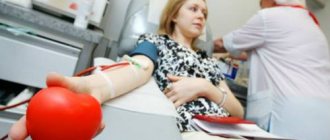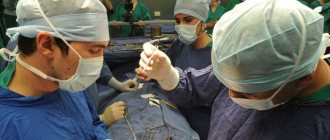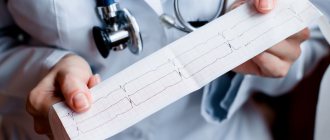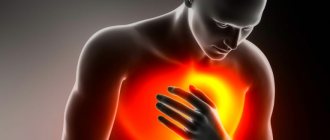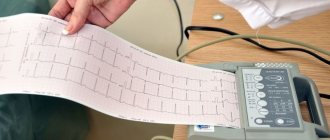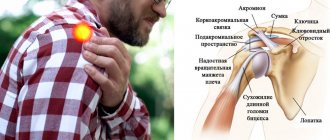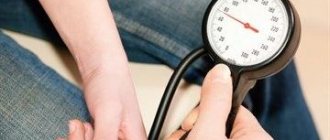Irregular heart rhythm or Heart arythmy occurs when the electrical impulses that initiate the heartbeat do not function correctly, causing the heart to beat too fast or too slow, or irregularly.
Arrhythmias are common and usually harmless. In most cases, a person feels a loss of one or more contractions, interruptions in the functioning of the heart - “it beats, then it doesn’t,” or a very rapid heartbeat. However, there are arrhythmias, the symptoms of which are dangerous, even life-threatening.
Advances in medical technology have enriched the physician with new therapeutic techniques and procedures that make it possible to control and eliminate arrhythmias. In addition, since arrhythmia can worsen, and in some cases, have a damaging effect on the heart (deplete the heart muscle, disrupt the functioning of the valve apparatus, cause an increase in the size of the cavities of the heart), the risk of arrhythmia can be reduced by adopting a healthy lifestyle, including proper nutrition and exercise.
Symptoms of arrhythmia
Arrhythmias may not appear. A doctor can detect an arrhythmia before it shows any signs during a routine clinical examination. But more often, heart rhythm disturbances cause noticeable changes in the condition, which include signs:
- Feeling of palpitations and chest pains
- Very fast heartbeat
- Extremely slow heartbeat
- Chest pain
- Shortness of breath
- Dizziness
- Loss of consciousness or feeling close to fainting
Even such significant symptoms of ill health do not always indicate a serious problem. Very often, people who experience an arrhythmia do not suffer from severe heart disease, while a person with a life-threatening arrhythmia may not have any complaints at all.
Normal heartbeat
The heart consists of 4 cavities. On each side, on the right and left, there are two pumps: on top of the atrium and below - the ventricles.
During cardiac contraction, chambers with a thin muscle layer and smaller sizes contract, helping to fill the relaxed ventricles with blood. Contraction begins when the sinus node—a small group of cells in the right atrium—sends an electrical impulse that causes both atria to contract. The impulse then travels to the atrioventricular node, located in the very center of the heart and lying at the junction of the atria and ventricles. Leaving the atrioventricular node, the impulse passes to the ventricles. As a result, the latter contract and push blood to all organs.
In a healthy heart, this process occurs evenly and constantly with a heart rate of 60-100 per minute in a calm state. In athletes, especially athletes at rest, the heart rate is usually less than 60, since their heart is much more trained than that of an ordinary person and has great muscle strength, pushing out a large volume of blood per contraction. In children, on the contrary, the pulse is normally more than 100 beats per minute, and in infancy it is 140-160 beats per minute.
Research methods
When the heart skips beats, the pathology can also be diagnosed using transesophageal electrocardiographic examination and through cardiac pacing. In addition, in medicine, a diagnostic method such as ultrasound is widely used, which makes it possible to evaluate not only the functional characteristics of the heart, but also its structure. Cardiac catheterization, which is an invasive technique through the insertion of a special catheter, also demonstrates good results.
If the heart skips beats, treatment should be immediate.
Causes of arrhythmia
The most common causes of arrhythmia or the condition leading to its development are heart disease, high blood pressure, diabetes, smoking, excessive consumption of alcohol and caffeine, drug abuse, and stress. In some cases, the causes of arrhythmias may be an overdose of certain medications, the use of dietary supplements and herbal preparations.
Scars can occur for various reasons. The most common of these is acute myocardial infarction. Such a scar prevents the formation of an electrical impulse and/or interrupts the passage of an impulse through the heart muscle.
In a healthy person with a healthy heart, the development of a stable arrhythmia is impossible without the presence of an external trigger, such as an electric shock. This happens primarily because in a healthy heart there are no pathological substrates for the development of arrhythmias, including scar tissue.
On the other hand, in hearts with signs of arrhythmia, the formation and/or propagation of the electrical impulse may be impaired, facilitating the development of the disease.
Any of the following conditions can lead to the development of arrhythmia:
○ Inadequate blood supply
. If blood flow to the heart is reduced for any reason, this can alter the cells' ability to form and conduct electrical impulses.
○ Damage or death of the heart muscle
. Damage or death of the heart muscle leads to a change in the path of electrical impulses propagating through it.
Among the heart disease causes of arrhythmias, the following are of particular importance:
○
Coronary heart disease (CHD)
. Despite the fact that many types of arrhythmias are recorded with ischemic heart disease, the most strongly associated with it are ventricular arrhythmias and sudden cardiac death. The narrowing of the arteries occurs until, as a result of lack of blood supply, part of the heart muscle dies (acute myocardial infarction). This can affect the process of propagation of an electrical impulse throughout the myocardium: small electrical circles of excitation are formed at the border of scar tissue, which disrupt the normal functioning of the heart, causing pathologically fast heartbeat (ventricular tachycardia) and ventricular flutter or fibrillation - ineffective chaotic contractions of the ventricles.
○ Cardiomyopathy
. It manifests itself as primary stretching and thinning of the walls of the ventricles and atria (dilated cardiomyopathy) or excessive thickening and overcontraction of the walls of the left ventricle (hypertrophic cardiomyopathy). With any variant of cardiomyopathy, the efficiency of cardiac output decreases (the amount of blood ejected by the left ventricle into the aorta to nourish all organs and tissues of the body decreases), and part of the blood remains in the left and right ventricles or is thrown back into the atria and the veins flowing into them.
Heart valve diseases. Damage to the heart valves by infectious agents or due to degenerative degeneration leads to narrowing of the valve openings and/or insufficient closure of the valves, i.e. valve insufficiency. When the chambers of the heart become stretched and weakened due to inadequate valve function, the risk of developing various types of heart rhythm disorders increases.
Extrasystole
Extrasystole is an extraordinary contraction of the heart muscle.
Its forms:
| By localization | Sinus Atrioventricular Atrial Ventricular |
| By frequency per hour | Rare (<10) Mid frequency (10–30) Frequent (>30) |
| By density | Single Pairs |
Extrasystoles occur for the same reasons as tachycardia. Often provoke the onset of paroxysm of tachyarrhythmia.
Extrasystole in most cases is asymptomatic, sometimes there are:
- interruptions in heart function;
- a feeling of increased heartbeat or stopping, cardiac arrest.
With heart failure, the course of the disease worsens and the risk of death increases. Single extrasystoles occur in healthy people and do not require correction. They respond well to treatment.
Treatment of extrasystole associated with damage to the heart muscle includes:
- beta blockers;
- ablation of foci of high-frequency extrasystole.
Risk factors for developing cardiac arrhythmia
Risk factors for developing cardiac arrhythmias include:
- ✔ Genetics.
In people with congenital abnormalities of the heart, arrhythmias occur more often. Moreover, a number of arrhythmias (eg, Wolff-Parkinson-White syndrome, some supraventricular tachycardias, some forms of long QT syndrome) are congenital. - ✔ Thyroid diseases.
With increased thyroid function, increased production of hormones occurs, overall metabolism increases, and heart contractions become more frequent and irregular. Atrial fibrillation most often develops. With insufficient thyroid function, metabolism decreases, which causes bradycardia, and in some cases, extrasystole. - ✔ High blood pressure.
This increases the risk of developing coronary heart disease. High blood pressure also causes the wall of the left ventricle to thicken, which can change the way impulses are conducted through it. - ✔ Diabetes mellitus.
Diabetes mellitus in the stage of decompensation (uncontrolled blood sugar levels) greatly increases the risk of developing coronary heart disease and arterial hypertension. In addition, episodes of hypoglycemia (low blood sugar) can be a trigger for the development of cardiac arrhythmias. - ✔ Electrolyte disturbances.
Electrolytes such as potassium, magnesium, sodium and calcium form the basis for the formation, maintenance and conduction of electrical impulses in the heart. Too high or too low concentrations of electrolytes in the blood and in heart cells affect the electrical activity of the heart and can cause the development of arrhythmias. - ✔ Use of stimulants.
Psychostimulants such as caffeine, nicotine, etc. cause the development of extrasystole and can also lead to the development of more severe heart rhythm disturbances over time. The use of amphetamines and cocaine can damage the heart muscle with the development of any of the existing arrhythmias and even lead to sudden cardiac death due to the development of ventricular fibrillation.
The heart seems to miss a beat: diagnosing the disorder
Diagnosis of this symptom is usually directed to performing various additional examinations. The main role in this is played by electrocardiographic examination. In addition, this type of disease can be diagnosed using Holter monitoring, which is a type of electrocardiographic study. Such a study makes it possible to provide long-term recording of heart rhythm when the patient is in his natural living conditions. Thus, doctors determine the dynamics of changes in the nature of rhythm disturbances in a certain period of time, which are compared with mental, physical and other stresses and situations.
Screening and diagnosis of arrhythmia
To diagnose arrhythmias, the doctor usually asks the patient if they have any heart disease and/or thyroid problems. In addition, specific types of medical testing are always performed to detect arrhythmia. This may be a short or long-term passive recording of an electrocardiogram (a day or more), or an attempt to provoke an arrhythmia while simultaneously continuously recording the heart rhythm.
Passive monitoring methods include:
- Electrocardiography (ECG). During an ECG, electrodes attached to specific locations on the arms, legs, and chest record the electrical activity of the heart. An electrocardiogram examines the intervals and duration of each phase of heart contraction.
- Daily ECG monitoring using the Holter method. A portable ECG recorder is installed for a day or more to record the electrical activity of the heart as a person performs his usual daily activities, as well as during sleep.
- Echocardiography. Allows you to use an ultrasound sensor to obtain an image of the chambers of the heart, clarify their sizes, the movement of the walls and valves and other information.
Arrhythmia can be induced using the following tests:
- Tests with physical activity . Some arrhythmias are triggered or worsened by exercise. During the “stress” test, a treadmill or stationary exercise bike is used. During the test, a continuous ECG recording is made. To perform a “stress” test, medications can be used that stimulate the heart in a similar way to physical exercise. Typically, this method is used when it is impossible to perform physical exercise, as well as to establish a diagnosis of coronary heart disease.
- Tilt table test . When a person has unexplained loss of consciousness, slant tests may be helpful. In this case, rhythm and blood pressure are monitored in a horizontal position for 20-30 minutes. Then a special table is moved to a vertical position and rhythm and blood pressure are also monitored for 10 minutes. In this way, the condition of the heart and the specialized nervous system that controls the functioning of the heart when changing body position and moving from a horizontal to a vertical position is assessed.
- Electrophysiological study and mapping . This study is carried out using the thinnest catheters - electrodes, which are carried into the heart cavity. When electrodes are installed in the area of certain areas of the conduction system of the heart, they can be used to study the propagation of an electrical impulse throughout the heart, induce arrhythmia, while studying its localization and mechanism, and also test the therapeutic effect of various medications. This is the most informative and accurate method for diagnosing most arrhythmias. In addition, when performing EPI, it is possible not only to identify, but also to eliminate the arrhythmogenic focus using a special thermal effect called radiofrequency. In this way, most supraventricular and some types of ventricular tachycardias are eliminated. Currently, this method is also used for atrial fibrillation.
First aid for yourself
Since such manifestations for the most part are still a reaction to some kind of emotionality, you should master methods of quickly calming yourself down. “The first thing to do when you’re nervous is to take a deep breath. This is a must to restore your breathing. This measure is used in case of an emotional explosion, if a person feels a reaction to stress in the form of heart palpitations. It is enough to spend a few minutes on this manipulation to feel much better.
Secondly, walking can be an excellent solution. You just need to move rhythmically for at least 5 minutes to calm your emotions and nerves. Measured, monotonous walking helps switch the nervous system from tension to a calmer mode. Another useful thing for emotional relief and recovery is to drink a glass of plain water. This is a great distraction - you just need to take a glass of water in small sips to get yourself in order. These “three pillars” are the main ones to dampen an emotional attack and calm the heartbeat.
If, over time, anxiety persists and thoughts do not calm down, you can, for example, add soothing tea. Brew it for yourself and distract the nervous system. But at this moment the heart should no longer beat too fast; this should not be done right away,” notes the cardiologist.
My heart trembled. When arrhythmia becomes deadly Read more
So there is no way to let a situation with an overly active heartbeat take its course. It should be kept under control and preferably in collaboration with a specialist. After all, many heart diseases can be asymptomatic and destroy the main muscle quite seriously even before it is detected.
Complications of arrhythmia
.
A number of heart rhythm disorders can increase the risk of developing conditions and diseases such as:
- Stroke
. When the atria fibrillate, they are unable to adequately pump blood to the ventricles. Slowing blood flow in the atria leads to the formation of clots. If a small piece breaks off from the clot, it can enter the bloodstream, spread throughout the body and clog the cerebral arteries, causing the development of ischemic stroke, i.e. damage or death of part of the brain, and sometimes leads to death. - Congestive heart failure
. Due to a prolonged period of bradycardia or tachycardia, such as atrial fibrillation, the heart may not pump efficiently. By controlling your heart rate, you can improve left ventricular contractility and reduce signs of heart failure.
How to get treatment at the Scientific Center named after.
A.N. Bakuleva? Online consultations
Temperature increase
If your body temperature “jumps” for no reason and there are no symptoms of a cold or other infections, you should consult a cardiologist. After all, such a manifestation may indicate the development of serious inflammatory heart problems, such as myocarditis or endocarditis. Please note that “heart” temperature has certain signs: even a slight increase is always accompanied by severe chills, it can last from 2 weeks to several months, and its severity can vary from 37.5 ° C to high numbers (38 or more).
Question answer
Why is a rapid heartbeat dangerous?

